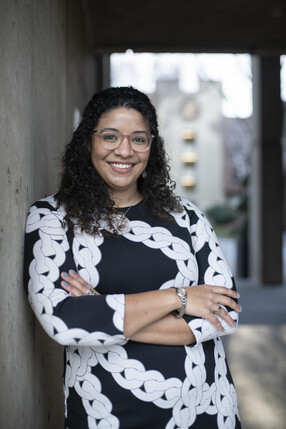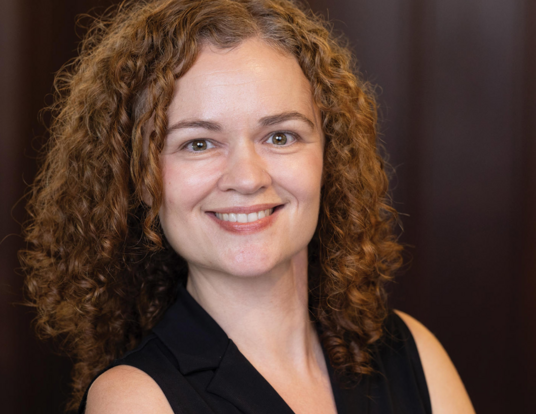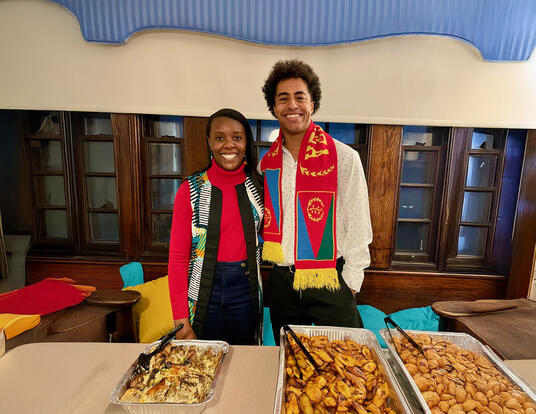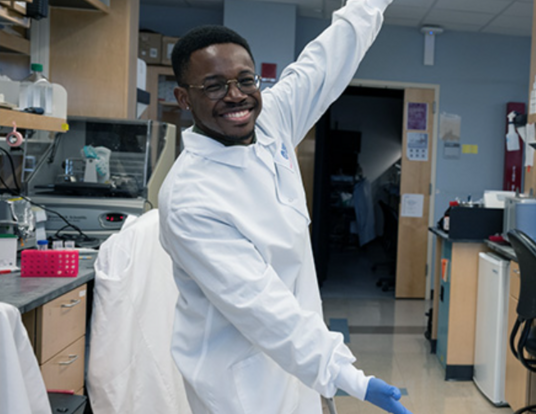Hungry for Change
Leah Gose studies the problem of hunger in order to help solve it

Research at Risk: Since World War II, universities have worked with the federal government to create an innovation ecosystem that has yielded life-changing progress. Now much of that work may be halted as funding is withdrawn. Find out more about the threats to medical, engineering, and scientific research, as well as how Harvard is fighting to preserve this work—and the University's core values.
Leah Gose started volunteering at a Somerville food pantry in 2017 as part of her work for a class on qualitative research methods. One day she was preparing a bag of food for an older man to take home to his wife. She noticed that his hands were dry and cracked. He had kind eyes. She packaged the pasta, the canned goods, and some meat and handed him the bag.
“Is that it for meat?” he asked, looking at her.
Gose froze. She was only authorized to give out what was in the bag. But why? Why couldn’t she simply give the man what he needed?
“I still think about him,” she says. “I don’t know if they went hungry after they ran out of food, he and his wife. I felt so powerless. I didn’t know how to solve the problem.”
Today Gose, a PhD student in sociology at Harvard’s Graduate School of Arts and Sciences (GSAS), contributes to a solution for the growing problem of hunger through research on the ways that local organizations are responding to the challenge. With a focus on the metropolitan Atlanta area where she grew up, Gose hopes to shed light on how citizens, nonprofits, schools, and politicians can work together to provide nutritional assistance, address barriers to access, and create policies that eliminate food insecurity.
A Growing Concern

Hunger is on the rise throughout the United States. While the problem is not new, the scope has increased dramatically during the pandemic. Last October, the nonprofit Feeding America estimated that around 50 million Americans experienced food insecurity in 2020, a rise of 43 percent from 2019. For society’s most vulnerable members the numbers are much worse: about 17 million children experienced food insecurity last year, up 70 percent from the year before.
“There's hunger everywhere,” Gose says. “You've got a lot of people who are new to it, people who have never been unemployed in their lives and now are experiencing either unemployment or underemployment. Many of them work in the service industry, which is a particularly large sector in metro Atlanta, where I’m doing my research.”
Just as many people are new to hunger, Gose says, many organizations and individuals are responding to the problem for the first time.
“Nutrition assistance is, in some ways, a really easy service to provide,” she explains. “You don’t need a ton of money. You can locate a pantry just about anywhere and operate it entirely on donations of food. As a result, traditional organizations like nonprofits and churches are being joined by schools, grocery stores, veterans’ groups, girl scout troops…even ballet studios and knitting groups.”
The good news about the increase in involvement is that it expands the network of people and organizations engaged with hunger relief and gives rise to innovative solutions. When COVID-19 hit Atlanta, for instance, the schools sent students home to mitigate the spread of the pandemic. The move meant that thousands of young people who depended on school lunch programs were suddenly without a nutritious meal—maybe their only one of the day. The federal government signaled that it would continue to reimburse school districts for the programs—if they could get the food to students.
In response, a patchwork of nonprofit organizations, religious groups, and individuals stepped in to do just that in a number of districts. Volunteers picked up the lunches and delivered them to students’ homes. Churches and libraries set up stations where families in the neighborhood could pick up meals. Nonprofit organizations paid for school buses to run their regular routes, delivering lunches instead of picking up students.
“The takeaway is that these grassroots efforts look a lot different than we think they might,” she says. “A school may double as a food pantry or administer a ‘backpack’ weekend nutrition program, but that doesn’t mean the principal is running things. Often, it’s a teacher or even a parent volunteer. A ‘ground-up’ approach to research lets you see all the informal partnerships that make these efforts work.”
No One Is Less
The bad news about handling hunger at the community level, however, is the variation in where, how, and how much assistance is provided—and to whom. One food pantry might allow patrons to visit once a week, another once a month. The type of food offered by pantries can differ widely too. And even organizations that are the face of a social safety net can put up barriers that make accessing nutrition assistance harder for some people and easier for others.
“Some pantries or kitchens might ask patrons to show a picture ID,” Gose explains. “Some might require proof of residence. Some organizations even require a certificate of marriage. I’m trying to show how the variation in the way that community organizations provide services—and to whom and in what contexts—results in huge variation at the community-level. These diverse responses are an effort to respond to diverse hunger needs but they also create inequality within the social safety net.”
Moreover, while hunger touches every age group in the Atlanta area, Gose says that not every age group benefits equally from efforts to address it. Solutions that get food to children, for instance, often don’t meet the needs of hungry seniors.
“You can target childhood hunger much more easily through schools,” Gose says. “That’s different than the way we might address the needs of people over the age of 65. If there's a food pantry in a senior center, that's likely more accessible to seniors or even to adults who are at working age.”
No one is less because they go to a food pantry. No one deserves to be hungry.
A larger issue is the need to distinguish between hunger and food insecurity. Gose says that pantries and soup kitchens offer short-term solutions to those who show up with an empty stomach. The problem of food insecurity—the experience of not knowing where one’s next meal will come from at least three times in a year—is a long-term issue that requires clear and effective public policy.
“To address food insecurity—to eliminate it—would require an expansion of the federal Supplemental Nutrition Assistance Program,” she says. “It would require affordable grocery stores in low-income communities, and, ultimately, higher wages. You can’t cook food if you have no electricity or gas for your stove. You can’t store fresh produce if your refrigerator doesn’t work.”
Real solutions to food insecurity—not just acute hunger—require bigger conversations and more creative ideas, Gose says. She hopes her research can inform those discussions. She still doesn’t know how to solve the problem that confronted her and the kind-eyed man in the food pantry that day, but she knows that she wants to help bring about a change.
“Our poverty solutions in the US are inadequate and exclusionary,” she says. “Understanding how communities respond to hunger is important for thinking about access, equity, and opportunities for intervention in the future. No one is less because they go to a food pantry. No one deserves to be hungry.”
Photos by Tony Rinaldo
Get the Latest Updates
Join Our Newsletter
Subscribe to Colloquy Podcast
Simplecast




